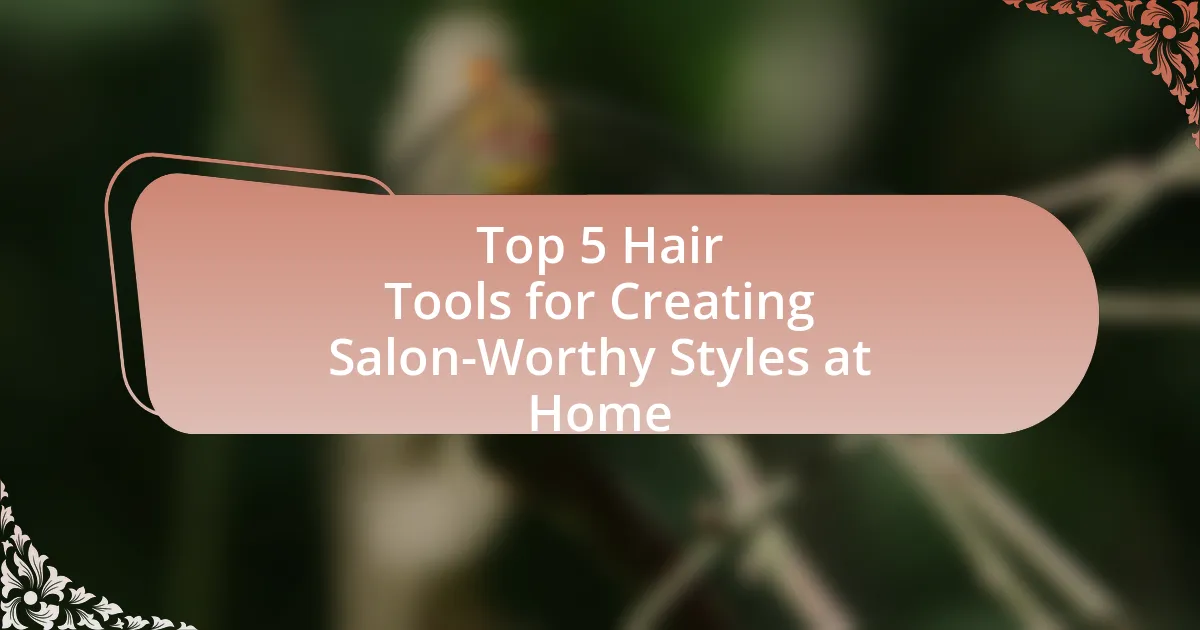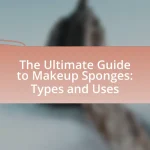The article focuses on the top five hair tools essential for creating salon-worthy styles at home: a hairdryer, curling iron, flat iron, round brush, and hair straightening brush. It details how these tools enhance the styling experience through features such as versatility, ease of use, and safety, while also comparing them to professional salon equipment. Additionally, the article emphasizes the importance of investing in quality tools for hair health, discusses optimal temperature settings for different hair types, and provides best practices for using and maintaining these tools effectively.
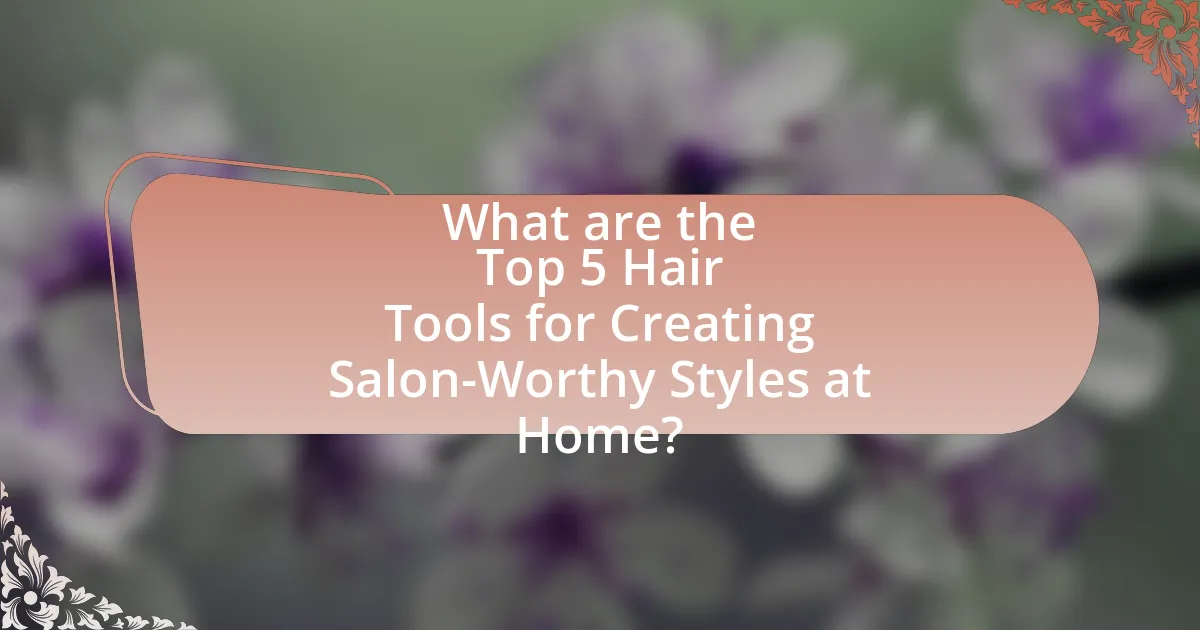
What are the Top 5 Hair Tools for Creating Salon-Worthy Styles at Home?
The top 5 hair tools for creating salon-worthy styles at home are a hairdryer, curling iron, flat iron, round brush, and hair straightening brush. A hairdryer is essential for quick drying and styling, often featuring multiple heat settings for versatility. A curling iron allows for creating defined curls and waves, with barrel sizes varying for different styles. A flat iron is crucial for achieving sleek, straight hair, utilizing ceramic or titanium plates for even heat distribution. A round brush is used in conjunction with a hairdryer to add volume and shape while blow-drying. Lastly, a hair straightening brush combines the benefits of a flat iron and a brush, providing a quick and easy way to straighten hair while minimizing heat damage. These tools are widely recognized in the beauty industry for their effectiveness in replicating professional salon results at home.
How do these tools enhance the styling experience?
These tools enhance the styling experience by providing professional-quality results and ease of use for at-home users. For instance, advanced hair dryers reduce drying time and minimize heat damage, while styling tools like curling wands and flat irons offer precise temperature control, allowing users to achieve desired styles without compromising hair health. Additionally, features such as ergonomic designs and lightweight materials improve comfort during use, making the styling process more enjoyable.
What features make these tools essential for home use?
The essential features of hair tools for home use include versatility, ease of use, and safety. Versatility allows users to create a variety of styles, from straightening to curling, making these tools suitable for different hair types and preferences. Ease of use ensures that individuals, regardless of their skill level, can achieve professional-looking results without extensive training. Safety features, such as automatic shut-off and heat-resistant materials, protect users from burns and accidents, enhancing the overall user experience. These characteristics collectively make hair tools indispensable for achieving salon-worthy styles at home.
How do these tools compare to professional salon equipment?
Home hair tools generally offer convenience and affordability compared to professional salon equipment, which is designed for high performance and durability. Professional equipment often features advanced technology, such as precise temperature control and higher wattage, resulting in faster styling and better results. For instance, professional hair dryers can reach higher temperatures and airflow rates, reducing drying time significantly compared to consumer-grade models. Additionally, salon tools are typically built to withstand frequent use, while home tools may have a shorter lifespan and less robust construction.
Why is it important to invest in quality hair tools?
Investing in quality hair tools is crucial because they enhance hair health and styling efficiency. High-quality tools, such as professional-grade hair dryers and straighteners, often feature advanced technology that minimizes heat damage and promotes better styling results. For instance, tools with ceramic or tourmaline plates distribute heat evenly, reducing the risk of hot spots that can burn hair. Additionally, quality tools tend to have longer lifespans, providing better value over time compared to cheaper alternatives that may break or underperform.
What impact do quality tools have on hair health?
Quality tools significantly enhance hair health by minimizing damage during styling. High-quality hair tools, such as ceramic or tourmaline flat irons and professional-grade hair dryers, distribute heat evenly and reduce the risk of overheating, which can lead to dryness and breakage. Research indicates that tools with advanced technology, like ionic or infrared heat, help retain moisture in the hair, resulting in shinier and healthier strands. Additionally, using well-designed brushes and combs can prevent tangling and reduce mechanical damage, further promoting overall hair vitality.
How can the right tools save time and effort in styling?
The right tools can save time and effort in styling by streamlining the process and enhancing efficiency. For instance, high-quality hair dryers with advanced technology can reduce drying time significantly, allowing users to achieve desired styles faster. Additionally, tools like curling wands and straighteners with quick heat-up features enable immediate styling without prolonged waiting periods. Research indicates that using professional-grade tools can cut styling time by up to 50%, making it easier for individuals to create salon-worthy looks at home.
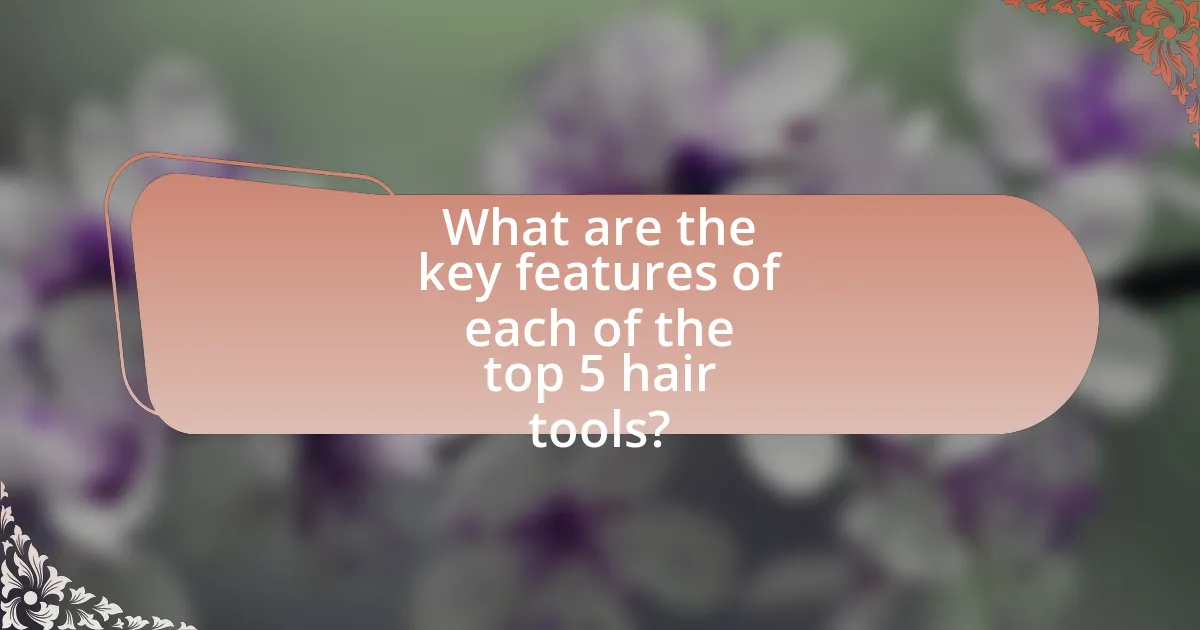
What are the key features of each of the top 5 hair tools?
The key features of the top 5 hair tools for creating salon-worthy styles at home include:
-
Hair Dryer: A powerful motor with multiple heat and speed settings, often featuring ionic technology to reduce frizz and enhance shine.
-
Flat Iron: Ceramic or titanium plates that heat evenly, adjustable temperature settings for different hair types, and a quick heat-up time for efficient styling.
-
Curling Wand: A tapered barrel design for versatile curl sizes, a heat-resistant glove for safety, and a fast heating capability to create long-lasting curls.
-
Hair Straightener Brush: A combination of bristles and heated plates for easy straightening, adjustable temperature control, and a lightweight design for comfortable use.
-
Hot Air Brush: A round brush head with built-in heating elements, multiple heat and speed settings, and the ability to dry and style hair simultaneously for added convenience.
What makes a hair dryer a must-have tool?
A hair dryer is a must-have tool because it significantly reduces drying time and enhances styling versatility. By utilizing heated air, hair dryers can quickly evaporate moisture from hair, allowing for faster preparation and styling. Studies show that using a hair dryer can cut drying time by up to 50%, making it an efficient choice for busy individuals. Additionally, modern hair dryers often come with multiple heat and speed settings, enabling users to achieve various styles, from sleek and straight to voluminous curls. This adaptability, combined with the time-saving aspect, solidifies the hair dryer’s essential role in achieving salon-worthy results at home.
How do different heat settings affect styling results?
Different heat settings significantly impact styling results by influencing the effectiveness and safety of hair tools. Higher heat settings can create more defined curls or straight styles quickly, but they also increase the risk of heat damage, leading to dryness and breakage. Conversely, lower heat settings may require more time to achieve the desired style but are generally safer for hair health, reducing the likelihood of damage. Research indicates that using heat tools at temperatures above 400°F can cause irreversible damage to hair proteins, while temperatures around 300°F are often sufficient for effective styling without excessive harm. Thus, selecting the appropriate heat setting is crucial for achieving optimal styling results while maintaining hair integrity.
What technologies enhance the performance of hair dryers?
Technologies that enhance the performance of hair dryers include ionic technology, ceramic heating elements, tourmaline, and smart heat sensors. Ionic technology reduces frizz and static by emitting negative ions that break down water molecules, allowing for faster drying. Ceramic heating elements provide even heat distribution, minimizing hot spots and preventing damage to hair. Tourmaline, a mineral that emits negative ions and infrared heat, further enhances drying efficiency and adds shine. Smart heat sensors automatically adjust the temperature based on hair moisture levels, ensuring optimal drying without overheating. These technologies collectively improve drying time, hair health, and styling results.
Why is a flat iron essential for versatile styling?
A flat iron is essential for versatile styling because it can create a variety of looks, including straight, wavy, and curled hair. This tool utilizes heated plates to effectively alter the hair’s texture, allowing users to achieve sleek, polished styles or soft, beachy waves. The ability to adjust the temperature settings on modern flat irons further enhances their versatility, accommodating different hair types and styles. Studies show that using a flat iron can reduce styling time by up to 50%, making it a practical choice for achieving salon-quality results at home.
What temperature settings are best for different hair types?
For fine or damaged hair, the best temperature setting is between 250°F to 300°F (121°C to 149°C) to prevent further damage. Medium hair types can tolerate temperatures from 300°F to 350°F (149°C to 177°C) for effective styling without excessive heat exposure. Coarse or thick hair requires higher temperatures, typically between 350°F to 400°F (177°C to 204°C), to achieve desired results efficiently. These temperature ranges are supported by hair care professionals who emphasize the importance of matching heat settings to hair texture to minimize damage and optimize styling effectiveness.
How can a flat iron be used for curling as well as straightening?
A flat iron can be used for curling by twisting the iron while pulling it through the hair, creating a spiral effect, while it straightens hair by simply gliding the plates down the strands. The technique for curling involves positioning the flat iron at an angle, wrapping the hair around the plates, and then gently pulling it through, which allows for the formation of curls. In contrast, straightening requires the flat iron to be moved straight down the hair shaft without twisting. This versatility is due to the flat iron’s design, which allows for both smooth, sleek finishes and defined curls, making it a multifunctional tool for styling hair at home.
What role does a curling wand play in achieving salon-quality curls?
A curling wand is essential for achieving salon-quality curls as it allows for precise styling and heat distribution. The design of a curling wand, typically featuring a tapered barrel, enables users to create a variety of curl sizes and shapes, mimicking professional techniques. Additionally, many curling wands incorporate advanced technologies, such as ceramic or tourmaline coatings, which help to minimize heat damage while providing even heat distribution, resulting in longer-lasting curls. Studies have shown that tools with these features can significantly enhance the quality of curls, making them appear more polished and professional.
What barrel sizes are available and how do they affect curl styles?
Barrel sizes for curling tools typically range from 0.5 inches to 2 inches in diameter. Smaller barrels, such as 0.5 to 1 inch, create tighter, more defined curls, while medium barrels, around 1 to 1.5 inches, produce loose waves and soft curls. Larger barrels, from 1.5 to 2 inches, result in voluminous, beachy waves. The choice of barrel size directly influences the curl style achieved, with smaller sizes yielding more structured curls and larger sizes offering a more relaxed look. This relationship between barrel size and curl style is well-documented in hairstyling resources, emphasizing the importance of selecting the appropriate size for desired results.
How can heat protectants be used with curling wands?
Heat protectants can be used with curling wands by applying them to dry hair before styling. This application creates a barrier that minimizes damage from the high temperatures of the curling wand, which can reach up to 450°F. Studies show that using heat protectants can reduce moisture loss and prevent hair breakage, thus maintaining hair health while achieving desired curls.
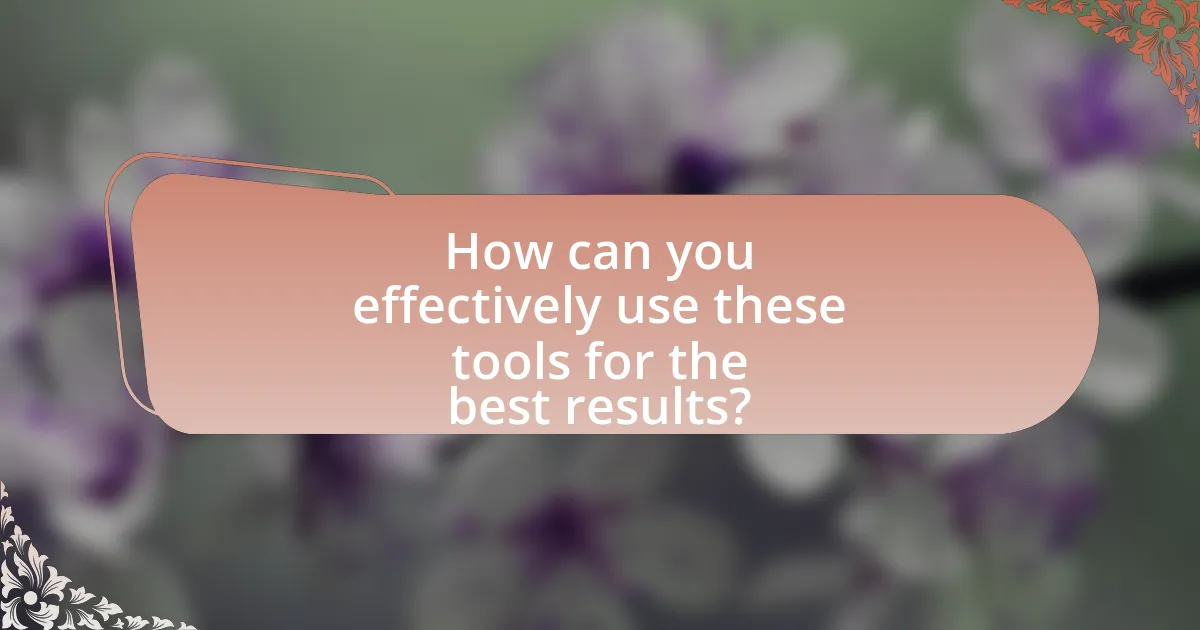
How can you effectively use these tools for the best results?
To effectively use hair tools for the best results, follow the manufacturer’s instructions for each tool to ensure optimal performance. For example, using a hair dryer with a nozzle attachment can direct airflow for more precise styling, while a flat iron should be used on dry hair to prevent damage. Additionally, incorporating heat protectant products before styling can safeguard hair from heat damage, enhancing the overall outcome. Studies show that using the right temperature settings on tools, such as a flat iron at 350°F for fine hair, can significantly reduce hair breakage and improve styling longevity.
What techniques should you follow for optimal styling?
To achieve optimal styling, utilize techniques such as sectioning hair, using heat protectants, and selecting the right tools for your hair type. Sectioning hair allows for more manageable styling and ensures even heat distribution, which is crucial for achieving a polished look. Applying heat protectants minimizes damage from styling tools, preserving hair health while enhancing shine. Additionally, choosing tools like a flat iron or curling wand that suit your specific hair texture—whether fine, thick, or curly—ensures better results and longevity of the style. These techniques are supported by professional hairstylists who emphasize the importance of preparation and the right equipment in achieving salon-worthy results at home.
How can sectioning hair improve styling outcomes?
Sectioning hair improves styling outcomes by allowing for more precise and controlled application of products and techniques. When hair is divided into manageable sections, it enables stylists to focus on one area at a time, ensuring even distribution of heat, product, or styling tools. This method reduces the risk of missing sections and enhances the overall finish, leading to a more polished look. Studies in hairdressing techniques indicate that sectioning can significantly improve the effectiveness of styling methods, as it allows for better access to the hair and minimizes the chances of damage.
What are the best practices for using heat tools safely?
The best practices for using heat tools safely include ensuring that the tool is used on dry hair, maintaining a safe distance from the scalp, and using a heat protectant product. Using heat tools on dry hair prevents moisture from causing damage, while keeping a safe distance minimizes the risk of burns. Additionally, applying a heat protectant can reduce hair damage by creating a barrier against high temperatures. According to the American Academy of Dermatology, using heat protectants can significantly lower the risk of hair damage, making these practices essential for safe heat tool usage.
What common mistakes should be avoided when using hair tools?
Common mistakes to avoid when using hair tools include using excessive heat, which can lead to hair damage and breakage. Many individuals fail to use a heat protectant, increasing the risk of thermal injury to the hair. Additionally, not cleaning tools regularly can result in product buildup, affecting performance and hygiene. Overusing tools without allowing hair to rest can also weaken strands, leading to long-term damage. Lastly, using the wrong tool for specific hair types can yield unsatisfactory results and further harm the hair.
How can improper use of tools damage hair?
Improper use of hair tools can damage hair by causing excessive heat exposure, mechanical stress, and chemical reactions. For instance, using a flat iron at too high a temperature can lead to protein denaturation in hair strands, resulting in brittleness and breakage. Additionally, using brushes or combs with excessive force can lead to mechanical damage, causing split ends and hair loss. Studies indicate that hair subjected to high temperatures above 450°F can lose moisture and structural integrity, leading to irreversible damage.
What are the signs that you may be using tools incorrectly?
Signs that you may be using hair tools incorrectly include experiencing excessive heat damage, uneven styling results, and discomfort during use. Excessive heat damage manifests as dry, brittle hair, indicating that the tool’s temperature is too high or being used for too long. Uneven styling results, such as inconsistent curls or flat sections, suggest improper technique or tool selection. Discomfort, such as pulling or tugging on hair, indicates that the tool may not be suitable for your hair type or that it is being used incorrectly. These signs highlight the importance of using hair tools properly to achieve desired results without damaging hair.
What tips can help you maintain your hair tools for longevity?
To maintain hair tools for longevity, regularly clean them after each use to prevent product buildup and damage. Cleaning tools like brushes and combs with warm soapy water removes hair and residue, while wiping down heated tools with a damp cloth prevents overheating and extends their lifespan. Additionally, storing tools in a dry, cool place protects them from moisture and heat damage. Using heat protectant sprays before styling can also minimize wear on tools. These practices are essential, as neglecting maintenance can lead to decreased performance and a shorter lifespan for hair tools.
